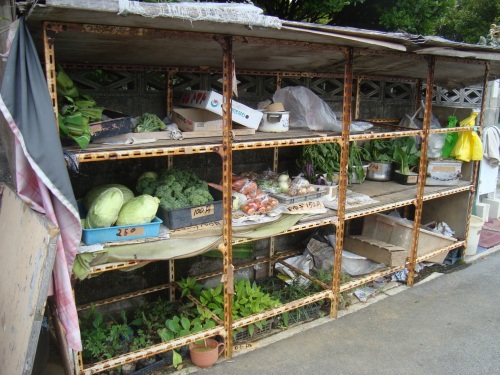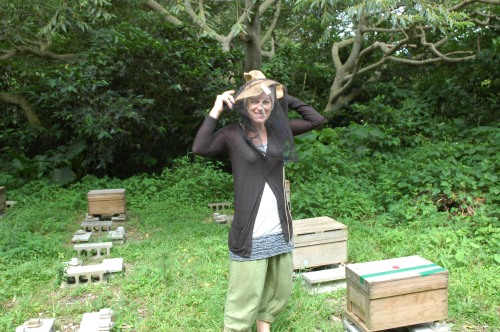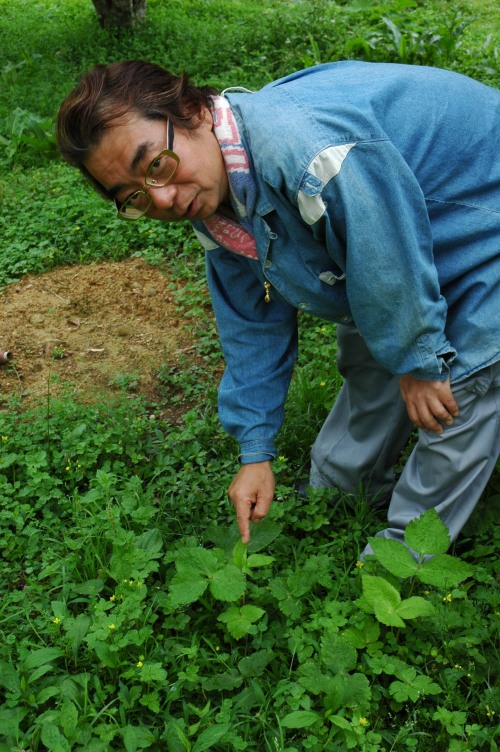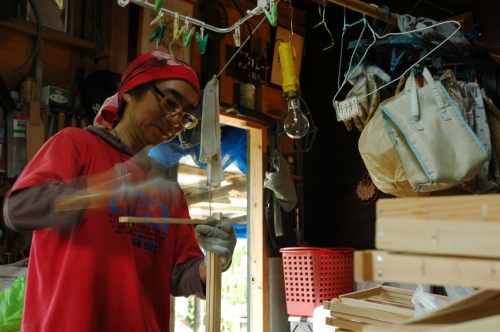Posted in Uncategorized | Leave a Comment »
Unmanned fruit & veggie stand in Okinawa
Something you rarely see in the UK but I’ve noticed is fairly common in rural areas of Japan are these unmanned fruit and veggie sales stands at the side of the roads.
These trusting rural Japanese folk leave their homegrown potatoes, carrots, onions, strawberries you name it next to a little money tin where their trustworthy customers can leave the correct amount for the produce they want and leave. I’ve even seen one selling fresh eggs in a type of homemade vending machine.

WOW, sorry to sound like a cynic but if that was the UK that money tin would be swiped within the hour! This is Japan though and it sums it up quite nicely. There is a remarkable amount of trust and reciprocity (some would even say naivety) amongst the Japanese people, especially the older generation.
Quite frankly I find it an endearing quality….
Posted in Gardening, Japan, Wwoofing | Tagged Gardening, Japan, Japanese food, wwoof | Leave a Comment »

The wild looking vegetable garden at Tomo sans house
OK back to the somewhat neglected looking veggie patch at Tomo and Tomoko sans house. My first Japanese veggie patch up close and personal. Over the past week as acting assistant chef to Akira san, I’ve been discovering that despite its unkept appearance there are some wonderful tasty delights hidden in that wild overgrowth.
There’s the regular produce that can be found commonly in the UK such as carrots, courgettes, lettuce, celery, asparagus etc. Then there’s the Japanese sweet potato (satsumaimo or さつまいも) growing in abudance here and easily recognisable (I was told) by the huge leaves and dark spot in the middle of the leaf. They almost grow like a vicious weed here popping up everywhere and anywhere
.
Japanese satsumaimo or sweet potato plant
There’s also 2 big coffee plants from which Tomo san has made small batches of coffee, just imagine that! Fresh coffee straight from the garden.

Unripe coffee beans!

Yummy papaya fruits in the garden

Cape gooseberry (or Japanese lanterns)
Also suited to the sub tropical climate here in Okinawa is papaya and cape gooseberries, the latter known more attractively also as “Japanese lanterns” such a sweet delicacy in the UK but here they’re growing everywhere. There’s also a bush at the front of the house producing fruit that look like blackberries but are longer and thinner (Tomoko san told me they are known as ku-a in Japanese but I can’t find any information on these on the net so perhaps I got the spelling wrong) Once I washed them (if you read my previous posts then you’ll know I only picked 5), I’d put them in a pan with some of the farms honey and simmer for a few minutes. This draws out the sweet juices. It makes a perfect accompaniment for plain yogurt at breakfast time, yum!
Posted in Uncategorized | Leave a Comment »
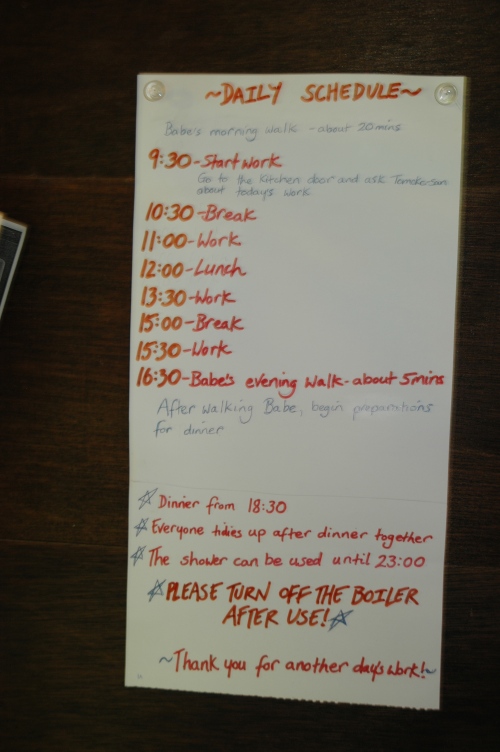
Daily schedule at the bee farm
So for any budding wwoofers out there wanting to know what their daily schedule might be, here’s mine (a previous wwoofer had translated this into English) I’m not going to lie, its a LONG day here at the bee farm. There are lots of breaks throughout the day but you’re up at 7am walking Babe the oh so gentle and senile dog through to finishing off the dishes from dinner at 8.30 maybe even 9pm.

Babe the dog
This wwoof host in particular is an exception in that we have to cook dinner for us and them every night. Most other wwoof hosts cook the meals (with your assistance) which I much preferred as I learnt Japanese cooking along the way and of course the pressure was off me to provide culinary masterpieces every night. Anyway apart from cooking dinner this is a fairly typical wwoofers daily schedule.
Posted in Japan, Wwoofing | Tagged Japan, Okinawa, wwoof | Leave a Comment »
My protective gear, one hat! Note my ankles are totally exposed…
So it’s been over a week I’ve been wwoofing here at the bee farm and although I’ve learnt a lot about honey/beeswax side products, I’ve yet to see any honey bees. This is partly due to the fact that Tomo san has had to keep his hives in separate places around the island and partly due to the fact he thinks girls won’t be able to handle being around the bees (the latter obviously making me reel!)

Tomo san with a frame hive
The very next day I was on my way to one of the 6 bee hive sites Tomo san has in Okinawa. Tomo san told me that in Okinawa he has 2 honey collection seasons, one around the end of April (unfortunately I will just miss it) and another in September. It’ll take Tomo san around 3 1/2 weeks to collect all the honey from his moveable frame hives. I didn’t realise before that beekeeping is so weather dependent as Tomo san explained that if the weather continues to be fine like it has been then more bees will be out collecting nectar and thus higher yields (how do they cope in England?!) Apparently Okinawa is an ideal location for beekeeping because not only is the climate so warm but there are so many wild and flowering weeds everywhere (they look like daisies).
Today Tomo san was checking the hives which involved smoking them out and then checking the frames.

Preparing to light the bee smoker
I was surprised with how little protective gear Tomo san was wearing but he insisted it was ample. I was given a hat with some tatty holed netting to wear too and considering I had 3/4 length trousers on thought it was a guarantee I’d be stung but….I didn’t! Every female beekeeper would have been proud, I didn’t go all “girly” when Tomo san pulled the frames out and the bees started flying everywhere. Felt quite proud of myself for a second until he told me these were the more placid hives! It’s definitely fuelled an interest and I want to learn more. Apparently my brother Ben has ordered a hive for the farm back home in England so hopefully I’ll get some hands on practice when I get back.
Oh and guess who got lucky and found the Queen bee within 2 minutes, can see her on this photo below? (clue: bottom-ish right)
.
Hard to communicate in broken English/Japanese with Tomo san so that’s about it as far as the bees go.
Posted in Bees, Japan, Wwoofing | Tagged Bees, Japan, Okinawa, organic, wwoof | Leave a Comment »
Akira san pointing out mitsuba for me
As assistant chef to Akira san I’ve been able to learn about some wild Japanese herbs that he uses to accompany some of his amazing ryotei looking dishes. As well as the familiar dill, parsley, mint in the garden and orchard I’ve also discovered mitsuba (みつば) which literally means “3 leaves”, and in English known as Japanese wild parsley or honeywort. It has a real spicy kick that I like, I guess I’d compare the taste as similar to rocket. Apparently the stalks can be blanched and used as a celery substitute.
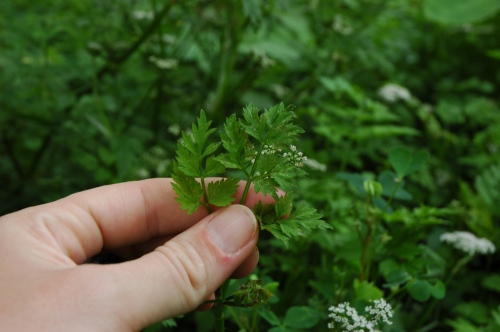
Japanese seri herb
Also making an appearance was seri (せり) which we managed to translate as “dropwort” in English. Some species of seri are extremely poisonous so I was thankful that the knowledgable Akira san was there to spot the right variety (memories of picking poisonous black ebony in the French Alps and ending up in hospital came flooding back) Seri doesn’t have the kick that mitsuba has but is quite tasty all the same.
We used the herbs in salads and in our homemade dressings but I later found out that these herbs form 2 of the 7 wild herbs used in creating nanakusa, a sort of rice porridge traditionally eaten on the 7th January every year in Japan for celebrating good health for the new year.
Posted in Cooking, Japan, Wwoofing | Tagged Cooking, Gardening, Japan, Japanese food, Okinawa, wwoof | Leave a Comment »
Necklaces for sale hanging up in front of my spotlessly clean windows!
Here’s a post to shatter anyones illusion that wwoofing equates to days frolicking in the sunshine pulling a few weeds out here and there. Today I spent the entire day cleaning Tomoko sans windows armed with a miniscule toothbrush and newspaper. Yep that’s right, she gave me a toothbrush for scrubbing the edges of the windows and the newspaper I was to dampen and use to clean the windows. Bought me back to my cadet days at school….Had my iPod for company though (recommended if you decide to go wwoofing) although my choice of listening to the history of Britain by Andrew Marr wasn’t really apt especially since I’d just hit episode 6, pearl harbour…all in all a depressing day!
Akira san in the workshop making bee hive frames
Akira san, my fellow Japanese wwoofer who seems to have got the rougher end of the deal, was busy in the workshop making a mountain of frames for the bee hives. If he’s not doing that he’s out in the garden weeding whilst a million mozzies attack him. I’m lucky that they don’t like my skin so I never get bitten but he has to carry around a anti mozzie candle wherever he goes and cover up head to toe. Poor thing.
Posted in Japan, Wwoofing | Tagged Japan, Okinawa, wwoof | Leave a Comment »
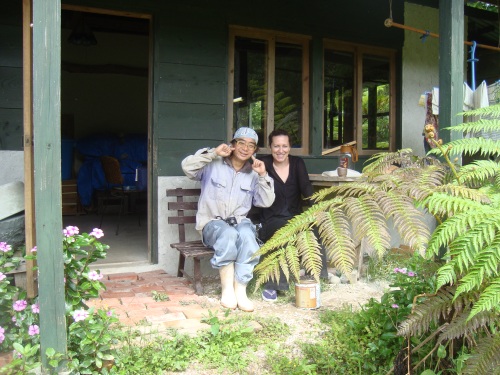
Taking a well earned break, Akira san and I
Tomoko sans favourite phrase and used on a daily basis. I get it that things shouldn’t be wasted and there are so many ways of saving money but sometimes I can’t help thinking that Tomo and Tomoko san are blurring the boundaries of being resourceful and just being plain old tight.
Oh god, can you tell I’m not loving it here?
Facing the bare facts, they have two wwoofers (who they obviously aren’t paying) walking the dog twice a day, cleaning, weeding, making hives and cooking their meals for them every night. Now I’d understand if they were flat-out busy but as I come back from my morning walk with Babe the dog every morning, I can hear Tomo san practicing on his guitar!
There is also the food that is bought for us to use. The bread for toast is always half price, past its sale by date fine but not so fine for the off tuna fish that had me running to the loo with my legs crossed for 2 days…
When I noticed the blackberry bush outside the house, I was told only to pick 5 at a time! When I spilt a thumbnail size of flour onto the table it was promptly mopped up and carefully put back in the flour jar. Poor Akira san who, prior to my arrival, had been drinking a concoction of lemongrass reeds for tea was shocked when I managed to get some green tea and coffee from Tomoko san and almost dropped to my knees with appreciation!
The pink pizzas served at the café, although look nice, wouldn’t fill up a small child and when I was making them everything was measured out to the nearest milligram, even the mushrooms! The café CD player is switched on and off throughout the day depending on whether there are customers.
Ok on a positive note, at least their weekly spend must be minimal! Since wwoofing I have noticed that Japanese households are less wasteful in general than us Westerners but is this one just crossing that boundary? Hmmm…I wonder.
Posted in Japan, Wwoofing | Tagged Japan, Okinawa, wwoof | Leave a Comment »
Akira san dropping his candles into the can of melted beeswax
This afternoon Tomoko san showed us these knobbly homemade beeswax candles she made for selling in her shop. Apparently candles aren’t that popular in Japan so she doesn’t make huge quantities but asked myself and Akira

My beeswax candles in the making…you can see one thin one on the outside of the tin
So first we tied the candle string to little bits of wood. Next melt the beeswax into a pan of simmering water and then dip the ends of the string into the hot beeswax one at a time and hang to dry. Once the first coat has been done, repeat until the candle gradually becomes thicker. Cut candle string shorter, wrap in cling film, label, job done. Simple!
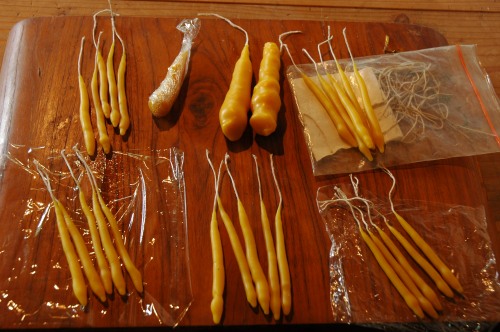
My knobbly homemade beeswax candles…!
Posted in Uncategorized | Leave a Comment »

Beeswax blocks (left) and finished handcream/lip balm in pots
Wow, ok this is why the hardwork pays off, today I got to make a beeswax cream from scratch. It can be used on any part of the body and is especially good as a lip balm. I never realised something like this could be as simple to make. Here are the ingredients;
100 grams of beeswax
340 grams extra virgin olive oil
2 doses of love
1 pinch of patience
Ok the latter two not needed but wanted to bulk out the ingredients list a bit. Yep it’s as simple as that, I couldn’t believe it. Watch my video and you’ll see how simple it is to make. I forgot to mention in the video that you have to melt and strain the fresh beeswax beforehand, then let cool and chop into 100 gram pieces. Then you can re-melt for the cream as I was doing.
Tomoko san sells these in her shop as well as a shop in Sendai (mainland Japan) that specialises in Okinawan products.

Half way through straining the beeswax
They sell for 700 yen each, about £5, not a bad little earner it seems but then factor in the amount of time + effort it takes in upkeeping the bees and it’s perhaps not as profitable as you might think.
The cream looked like lip balm but was really soft on the skin, Tomoko san uses it every morning, I might just give it a go, anything to get rid of the rapidly developing wrinkles…

My finished beeswax cream in pots ready for labelling
Posted in Bees, Japan, Wwoofing | Tagged Bees, Japan, Okinawa, wwoof | Leave a Comment »

